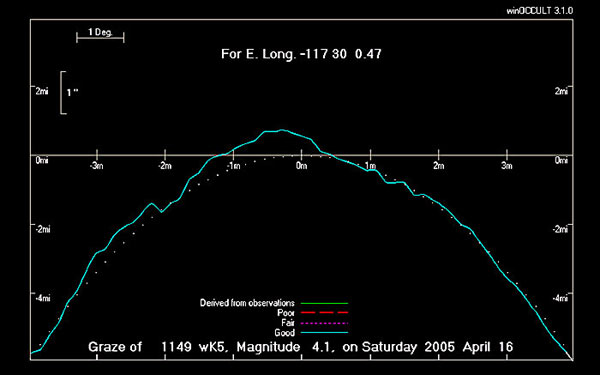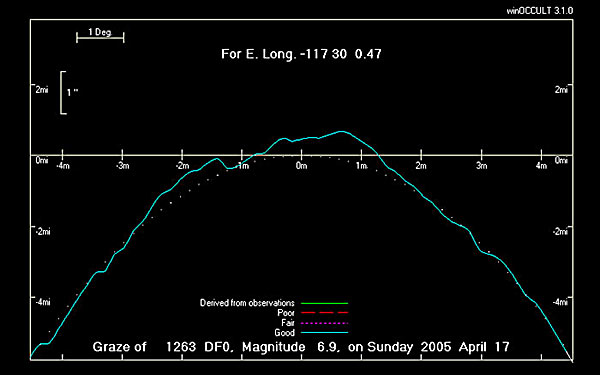Our Astro 28M Weekend Grazes
Upsilon Geminorum Graze - Friday evening April 15
 First,
on Friday night April 15 we are treated to a spectacular graze of the 4.1 magnitude
star Upsilon Geminorum. This is a bright star visible to the naked eye when
not in the glare of the moon. The graze occurs 13 degrees from the northern
cusp of the 45% waxing cresent moon high in the sky. The profile of the moon
(vertical is exagerated by a factor of 20) is shown here. The star will be seen
to move from left to right. Our goal will be to choose observing sites which
maximize the probability that the star disappears and reappears many times among
the hills on the dark side of the moon. The prediction sheet is here.
First,
on Friday night April 15 we are treated to a spectacular graze of the 4.1 magnitude
star Upsilon Geminorum. This is a bright star visible to the naked eye when
not in the glare of the moon. The graze occurs 13 degrees from the northern
cusp of the 45% waxing cresent moon high in the sky. The profile of the moon
(vertical is exagerated by a factor of 20) is shown here. The star will be seen
to move from left to right. Our goal will be to choose observing sites which
maximize the probability that the star disappears and reappears many times among
the hills on the dark side of the moon. The prediction sheet is here.
The graze occurs at 9:48pm. Our graze site will be north of Mojave, about 15
miles south of our campground. If you're coming directly to the graze site and
not driving on to the campground first, then look for Randsburg Cutoff. The
Mapquest.com map suggests that Randsburg Cutoff now does not connect to the
interstate coming down from Tehachapi. If you don't see an offramp, then go
a couple miles further to "Business Hwy 58" and get off, heading north.
A mile further will bring you to Randsburg Cutoff and you turn left. Use the
mapquest
map here, and the zoom feature to look at the dirt roads. The north end
of our grazers will be 0.5mi north of the limit line. The "x"
on the topographic map here is 0.5mi N, where the Los Angeles aqueduct crosses
Randsburg Cutoff road
Because it's a long 6 hour drive from Santa Cruz, you'll have to decide carefully
whether to have dinner in camp and head to the graze site, or instead to plan
to have dinner on the road intercepting arriving students before they reach
Red Rock Canyon, perhaps in Mojave itself, and then go straight to the graze
site. I will get to the campground ASAP in order to secure spots during this
popular time of the year for the desert. Dave McKulle plans to leave around
10am and should get there by 3:30-4pm. I hope to get there a bit earlier. We'll
have to leave the campground by 7:50pm sharp in order to get to the graze site
and set up our scopes.
ZC 1263 Graze - Saturday Evening
 Even
more interesting is the graze of the triple star ZC 1263. The brightest star
of the system is magnitude 6.9. There is a second star at magnitude 7.7 whose
graze path is 6 miles further south. This 7.7 star is actually a close spectroscopic
binary of ~8.5 + 8.5 stars separated by 0.155" (about 0.2 miles - easily
resolvable for our observers) along a roughly north/south direction. The 6.9
star will disappear and reappear all at once, but the 7.7 star will disappear
and reappear in steps, first fading roughly at half brightness. The profile
for these grazes is much more favorable than for the previous night's Upsilon
Geminorum graze, promising many timings. Our data should help refine the position
and orientation of this multiple star system, and be quite spectacular to watch.
The 6.9 and 7.7 components are separated by 5.4 arc seconds, easily resolved
by our telescope equipment and will be visible as a close binary pair. We'll
have to plan out where to put observers, but it already seems that the 7.7 star
should be more of the attention, and should be where the video camera gear should
go. Hopefully we'll have astronomy club people along with their scopes and visual
observers can concentrate on the brighter 6.9 star graze. The other nice thing
about watching the 6.9 graze is that the fainter 7.7 graze will happen as well,
but just deep enough into the lunar profile so that we should not expect multiple
mountains to cause occultations. The prediction sheet is here.
Even
more interesting is the graze of the triple star ZC 1263. The brightest star
of the system is magnitude 6.9. There is a second star at magnitude 7.7 whose
graze path is 6 miles further south. This 7.7 star is actually a close spectroscopic
binary of ~8.5 + 8.5 stars separated by 0.155" (about 0.2 miles - easily
resolvable for our observers) along a roughly north/south direction. The 6.9
star will disappear and reappear all at once, but the 7.7 star will disappear
and reappear in steps, first fading roughly at half brightness. The profile
for these grazes is much more favorable than for the previous night's Upsilon
Geminorum graze, promising many timings. Our data should help refine the position
and orientation of this multiple star system, and be quite spectacular to watch.
The 6.9 and 7.7 components are separated by 5.4 arc seconds, easily resolved
by our telescope equipment and will be visible as a close binary pair. We'll
have to plan out where to put observers, but it already seems that the 7.7 star
should be more of the attention, and should be where the video camera gear should
go. Hopefully we'll have astronomy club people along with their scopes and visual
observers can concentrate on the brighter 6.9 star graze. The other nice thing
about watching the 6.9 graze is that the fainter 7.7 graze will happen as well,
but just deep enough into the lunar profile so that we should not expect multiple
mountains to cause occultations. The prediction sheet is here.
The site
for these events is further south; north of Lancaster and west of Edwards
Air Force Base - site of the shuttle landings. The graze is at 8:52pm, time
enough for us to have dinner and then caravan from camp.
 First,
on Friday night April 15 we are treated to a spectacular graze of the 4.1 magnitude
star Upsilon Geminorum. This is a bright star visible to the naked eye when
not in the glare of the moon. The graze occurs 13 degrees from the northern
cusp of the 45% waxing cresent moon high in the sky. The profile of the moon
(vertical is exagerated by a factor of 20) is shown here. The star will be seen
to move from left to right. Our goal will be to choose observing sites which
maximize the probability that the star disappears and reappears many times among
the hills on the dark side of the moon. The prediction sheet is here.
First,
on Friday night April 15 we are treated to a spectacular graze of the 4.1 magnitude
star Upsilon Geminorum. This is a bright star visible to the naked eye when
not in the glare of the moon. The graze occurs 13 degrees from the northern
cusp of the 45% waxing cresent moon high in the sky. The profile of the moon
(vertical is exagerated by a factor of 20) is shown here. The star will be seen
to move from left to right. Our goal will be to choose observing sites which
maximize the probability that the star disappears and reappears many times among
the hills on the dark side of the moon. The prediction sheet is here. Even
more interesting is the graze of the triple star ZC 1263. The brightest star
of the system is magnitude 6.9. There is a second star at magnitude 7.7 whose
graze path is 6 miles further south. This 7.7 star is actually a close spectroscopic
binary of ~8.5 + 8.5 stars separated by 0.155" (about 0.2 miles - easily
resolvable for our observers) along a roughly north/south direction. The 6.9
star will disappear and reappear all at once, but the 7.7 star will disappear
and reappear in steps, first fading roughly at half brightness. The profile
for these grazes is much more favorable than for the previous night's Upsilon
Geminorum graze, promising many timings. Our data should help refine the position
and orientation of this multiple star system, and be quite spectacular to watch.
The 6.9 and 7.7 components are separated by 5.4 arc seconds, easily resolved
by our telescope equipment and will be visible as a close binary pair. We'll
have to plan out where to put observers, but it already seems that the 7.7 star
should be more of the attention, and should be where the video camera gear should
go. Hopefully we'll have astronomy club people along with their scopes and visual
observers can concentrate on the brighter 6.9 star graze. The other nice thing
about watching the 6.9 graze is that the fainter 7.7 graze will happen as well,
but just deep enough into the lunar profile so that we should not expect multiple
mountains to cause occultations. The prediction sheet is
Even
more interesting is the graze of the triple star ZC 1263. The brightest star
of the system is magnitude 6.9. There is a second star at magnitude 7.7 whose
graze path is 6 miles further south. This 7.7 star is actually a close spectroscopic
binary of ~8.5 + 8.5 stars separated by 0.155" (about 0.2 miles - easily
resolvable for our observers) along a roughly north/south direction. The 6.9
star will disappear and reappear all at once, but the 7.7 star will disappear
and reappear in steps, first fading roughly at half brightness. The profile
for these grazes is much more favorable than for the previous night's Upsilon
Geminorum graze, promising many timings. Our data should help refine the position
and orientation of this multiple star system, and be quite spectacular to watch.
The 6.9 and 7.7 components are separated by 5.4 arc seconds, easily resolved
by our telescope equipment and will be visible as a close binary pair. We'll
have to plan out where to put observers, but it already seems that the 7.7 star
should be more of the attention, and should be where the video camera gear should
go. Hopefully we'll have astronomy club people along with their scopes and visual
observers can concentrate on the brighter 6.9 star graze. The other nice thing
about watching the 6.9 graze is that the fainter 7.7 graze will happen as well,
but just deep enough into the lunar profile so that we should not expect multiple
mountains to cause occultations. The prediction sheet is